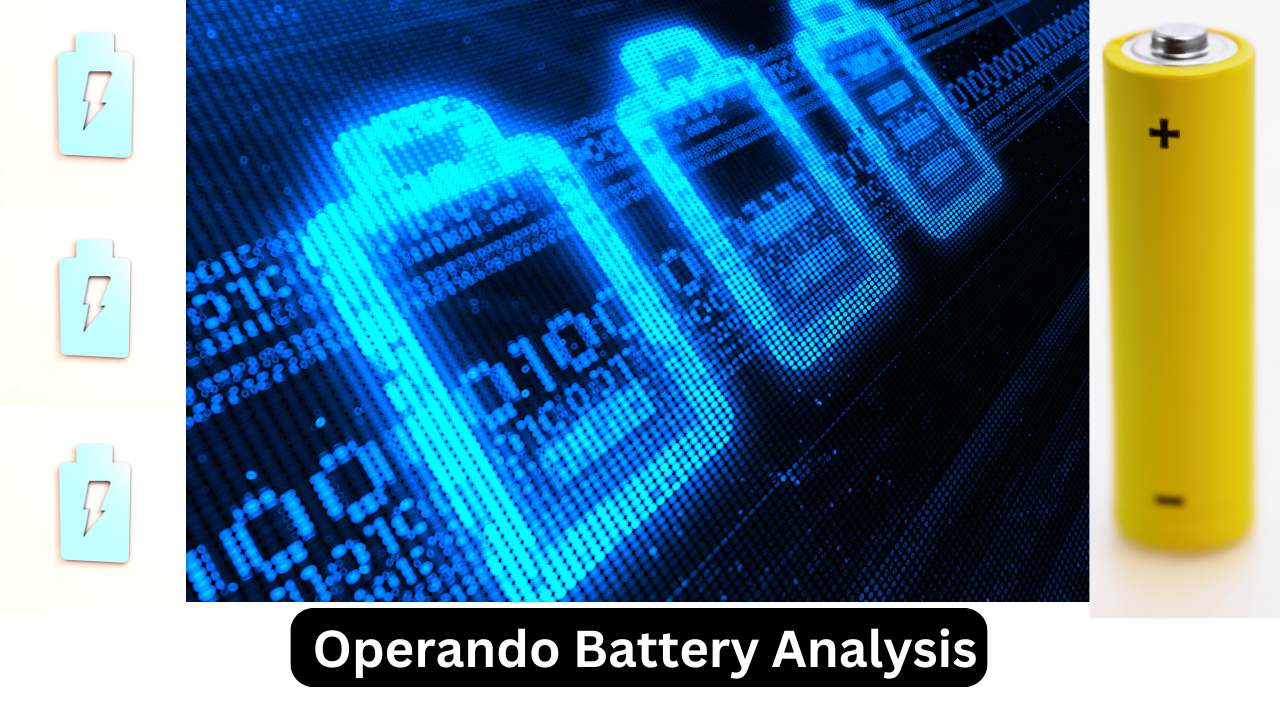Operando Battery Analysis provides real-time insights into battery performance, identifying degradation processes and improving efficiency through advanced techniques like DEMS, FTIR, and X-ray absorption spectroscopy.
As the world shifts towards sustainable energy solutions, battery technology stands at the forefront of this movement, powering devices from smartphones to electric vehicles. With the ever-growing complexity of battery chemistries, researchers require advanced tools to analyze and optimize battery performance. One of the most promising approaches is operando battery analysis, which enables scientists to observe the internal workings of a battery in real-time, under actual operating conditions. Unlike traditional analysis methods, operando techniques offer deeper insights into battery behavior, allowing researchers to refine battery designs for better longevity and efficiency. This article delves into the techniques for operando battery analysis, their challenges, and their significant impact on advancing battery technology.
The Evolution of Battery Analysis Methods
In the early stages of battery research, post-mortem analysis was the primary method for examining battery components. This involved disassembling a battery after use to analyze its internal materials and determine what caused degradation. However, this approach has limitations as it cannot provide real-time data on a functioning battery, and the act of opening the battery can alter its chemistry. Next, in situ analysis was developed, allowing scientists to examine batteries during a paused state. But even this approach does not offer a complete view of the dynamic chemical processes that occur when a battery is actively charging or discharging.
Operando battery analysis addresses these challenges by enabling the real-time observation of batteries under normal operating conditions. This technique has emerged as an indispensable tool for researchers, allowing them to study various parameters, including ion movement, thermal behavior, and side reactions, without disrupting the battery’s natural state. Operando methods, while complex, have opened a new chapter in battery research, empowering scientists to make data-driven improvements to battery design.
Key Techniques for Operando Battery Analysis

1. Differential Electrochemical Mass Spectrometry (DEMS)
Differential Electrochemical Mass Spectrometry (DEMS) is a powerful tool for analyzing the gaseous by-products generated during battery operation. By coupling a mass spectrometer with an electrochemical cell, researchers can detect gas molecules that emerge due to chemical reactions, especially during extreme conditions like high voltage or fast charging. DEMS is particularly effective for identifying side reactions that degrade battery materials, helping researchers to pinpoint factors that contribute to battery aging and capacity loss.
DEMS involves the use of a carrier gas to transport gaseous by-products from the battery to the mass spectrometer. This setup allows scientists to monitor the breakdown of the electrolyte and other battery components as they interact under real-time operational conditions. Despite its utility, DEMS has challenges, including the potential for gas bubbles to interfere with measurements. Researchers mitigate these issues by reviewing mass spectrometry data holistically, identifying specific combinations of by-products indicative of battery degradation.
Advantages and Limitations of DEMS in Operando Battery Analysis
| Feature | Advantage | Limitation |
|---|---|---|
| Real-time monitoring | Allows immediate detection of degradation | Gas bubbles may affect data accuracy |
| Identification of side reactions | Helps in understanding battery aging | Complex setup and requires excess electrolyte |
| Application for various chemistries | Suitable for multiple battery types | Limited to gas-producing reactions |
2. Fourier Transform Infrared Spectroscopy (FTIR)
Fourier Transform Infrared Spectroscopy (FTIR) is an optical technique that provides insights into the molecular structure of battery components by analyzing how they interact with infrared light. This method is especially valuable for studying the ion transport within the electrolyte and identifying factors that impact the stability of this essential component. Researchers like Jason Porter have pioneered the use of FTIR in batteries, developing specialized setups to accommodate the unique challenges of operando analysis.
In FTIR analysis, scientists create coin cells on a diamond window, through which an infrared beam reflects, allowing for the detection of molecular vibrations. By examining shifts in these vibrations, they can infer the concentration of ions, including lithium ions, within the battery. FTIR is crucial for identifying how solvent molecules interact with ions, offering insights that can enhance battery charge rates and overall performance.
3. X-ray Absorption Spectroscopy
X-ray Absorption Spectroscopy is another technique used in operando battery analysis, enabling researchers to study the local atomic environment and electronic state of battery materials. This technique is highly sensitive and can often be applied without requiring modifications to the battery, making it ideal for non-invasive analysis. By observing how atoms absorb X-rays, scientists can gain information on the structure and chemical composition of electrode materials, which play a significant role in battery performance.
While X-ray absorption spectroscopy is invaluable for battery analysis, it requires access to synchrotron radiation sources, which are costly and difficult to schedule. Despite these limitations, the data obtained from this technique has proven critical in understanding how electrode materials degrade over time, guiding the development of more durable battery components.
Challenges in Operando Battery Analysis
Operando battery analysis offers unparalleled insights, but it also presents several challenges that researchers must address to advance the field.
- Sensitivity and Scale: Operando techniques operate at very small scales, often requiring the ability to monitor processes within layers just a few microns thick. Imaging at these scales while maintaining realistic operating conditions is a complex technical feat.
- Sample Integrity: Altering a battery’s structure to accommodate analysis tools can affect the accuracy of data. Researchers must strike a balance between making a battery accessible for analysis and preserving its natural state.
- Data Complexity: Operando analysis generates vast amounts of data, which can be challenging to interpret. Using machine learning and other AI-driven methods, researchers can process and analyze this data more effectively, revealing patterns that may otherwise go unnoticed.
Complementary Techniques for Comprehensive Battery Insights

No single operando technique can capture all aspects of battery behavior, so researchers often combine multiple methods to form a complete picture of a battery’s performance. By integrating optical, mass spectrometric, and X-ray techniques, scientists can create a more accurate representation of battery processes. This synergy enables them to tackle complex issues, such as electrolyte stability, electrode degradation, and ion transport, from multiple angles, leading to more reliable and insightful data.
The integration of operando data with AI-based models is an emerging area that holds great promise. Machine learning can analyze complex data sets from thousands of batteries tested under various conditions, correlating performance metrics with specific chemical changes. This approach has the potential to accelerate battery research by identifying optimal combinations of materials and operating conditions for maximum efficiency and lifespan.
Frequently Asked Questions (FAQs)
1. What is operando battery analysis?
Operando battery analysis is a technique that enables researchers to study the internal processes of a battery in real-time, under actual operating conditions. This approach provides insights into battery behavior that traditional methods cannot capture.
2. How does differential electrochemical mass spectrometry (DEMS) help in battery analysis?
DEMS is used to analyze the gaseous by-products released during battery operation. By studying these gases, researchers can identify side reactions that contribute to battery degradation, aiding in the development of longer-lasting batteries.
3. What role does FTIR play in operando analysis?
FTIR is an optical technique that examines molecular interactions within the battery’s electrolyte, especially ion transport. Understanding these interactions can lead to improvements in battery charge rates and stability.
4. Why is X-ray absorption spectroscopy important for battery research?
X-ray absorption spectroscopy provides information on the atomic structure and composition of battery materials, offering insights into how these materials degrade over time. This knowledge is crucial for designing durable battery components.
5. What are the main challenges of operando battery analysis?
The main challenges include maintaining sample integrity, achieving high sensitivity at small scales, and managing the complexity of the data generated. Researchers often use complementary methods and AI to overcome these issues.
6. Can AI improve operando battery analysis?
Yes, AI can process and analyze complex data sets from operando studies, identifying patterns that can guide battery optimization. Machine learning algorithms are particularly useful for correlating chemical changes with battery performance.
7. How does operando analysis differ from post-mortem and in situ analysis?
Operando analysis is conducted in real-time while the battery is operating, whereas post-mortem analysis occurs after the battery is dismantled, and in situ analysis is performed during a paused state of operation.
8. What are some future applications of operando battery analysis?
As battery technology advances, operando analysis will play a key role in developing batteries for electric vehicles, grid storage, and portable electronics by enabling faster and more efficient research into new materials and designs.
Conclusion: The Future of Operando Battery Analysis
The field of operando battery analysis is still evolving, but its impact on battery research and development is already substantial. By providing real-time insights into the complex processes within batteries, operando techniques have the potential to revolutionize battery design, enhancing durability, efficiency, and safety. As demand for high-performance batteries continues to rise, the need for advanced operando techniques will only grow, spurring further innovation. Embracing this approach will enable researchers and manufacturers to keep pace with the rapid advancements in battery technology, paving the way for a more sustainable and energy-efficient future. Please follow out blog Technoloyorbit.



